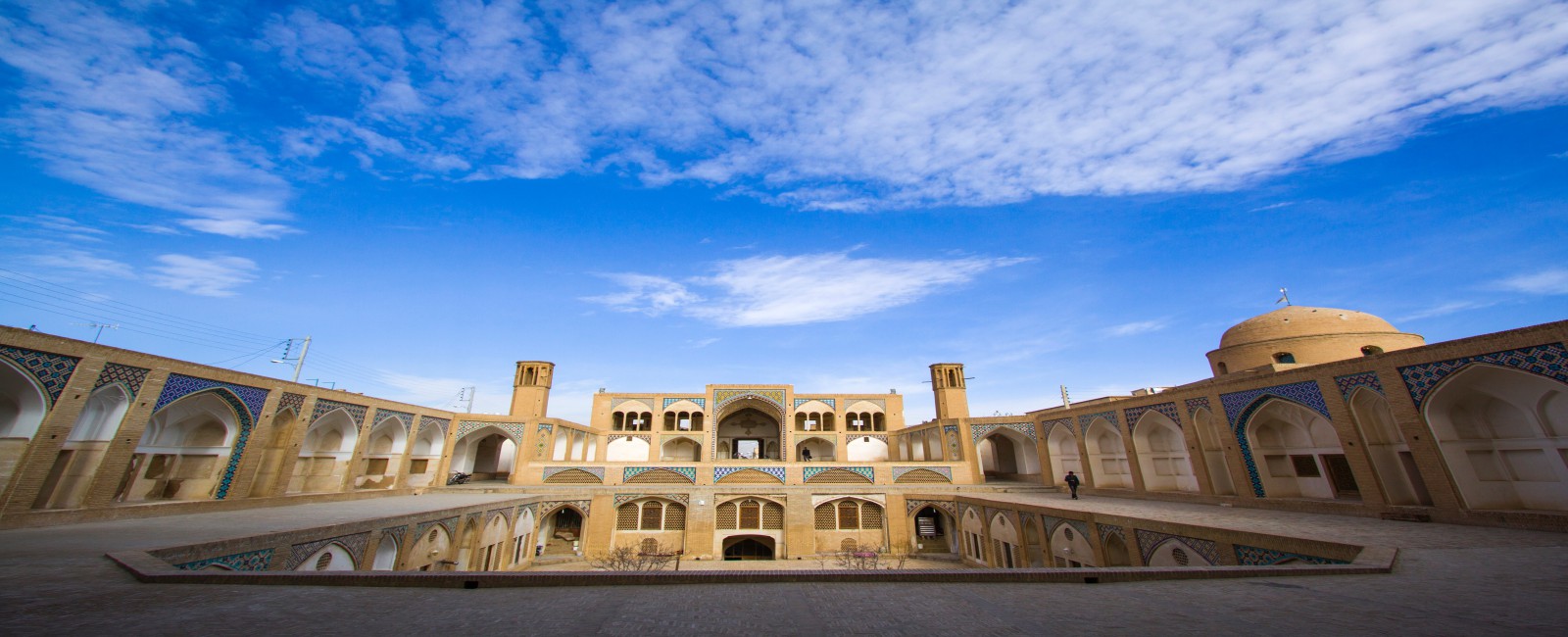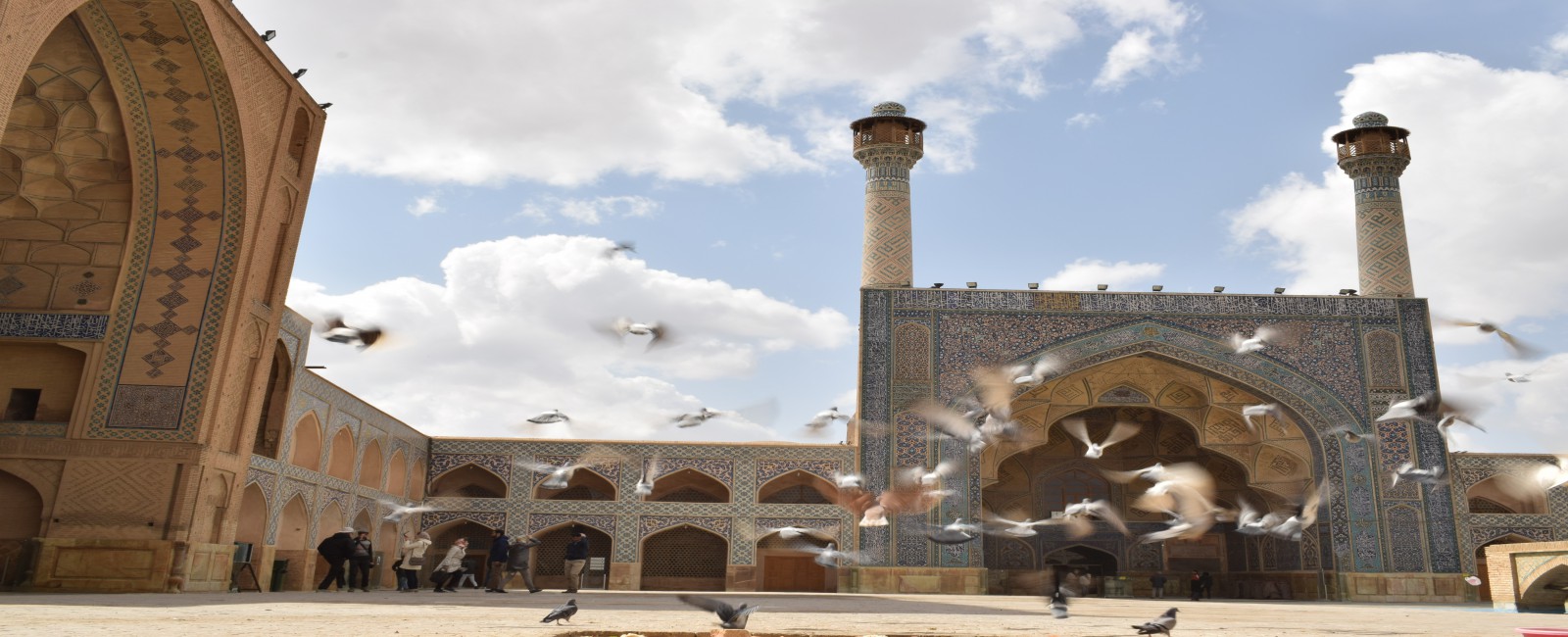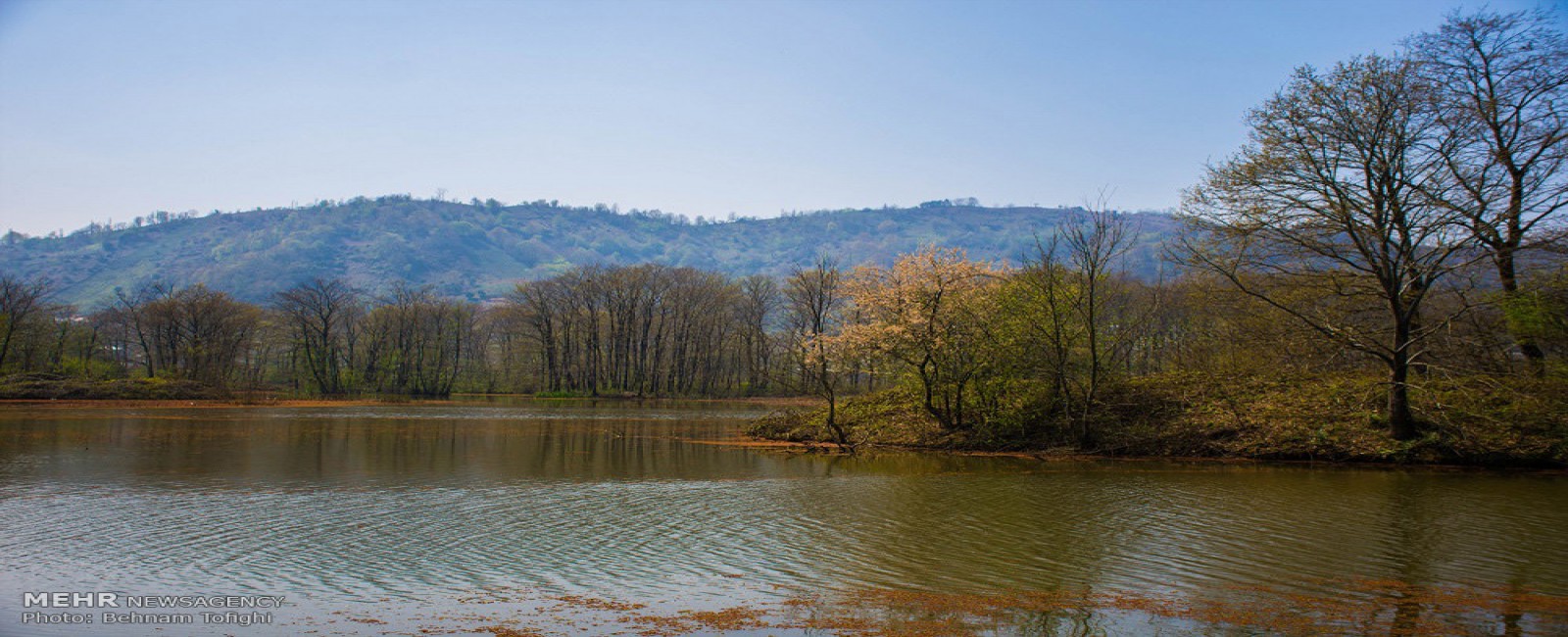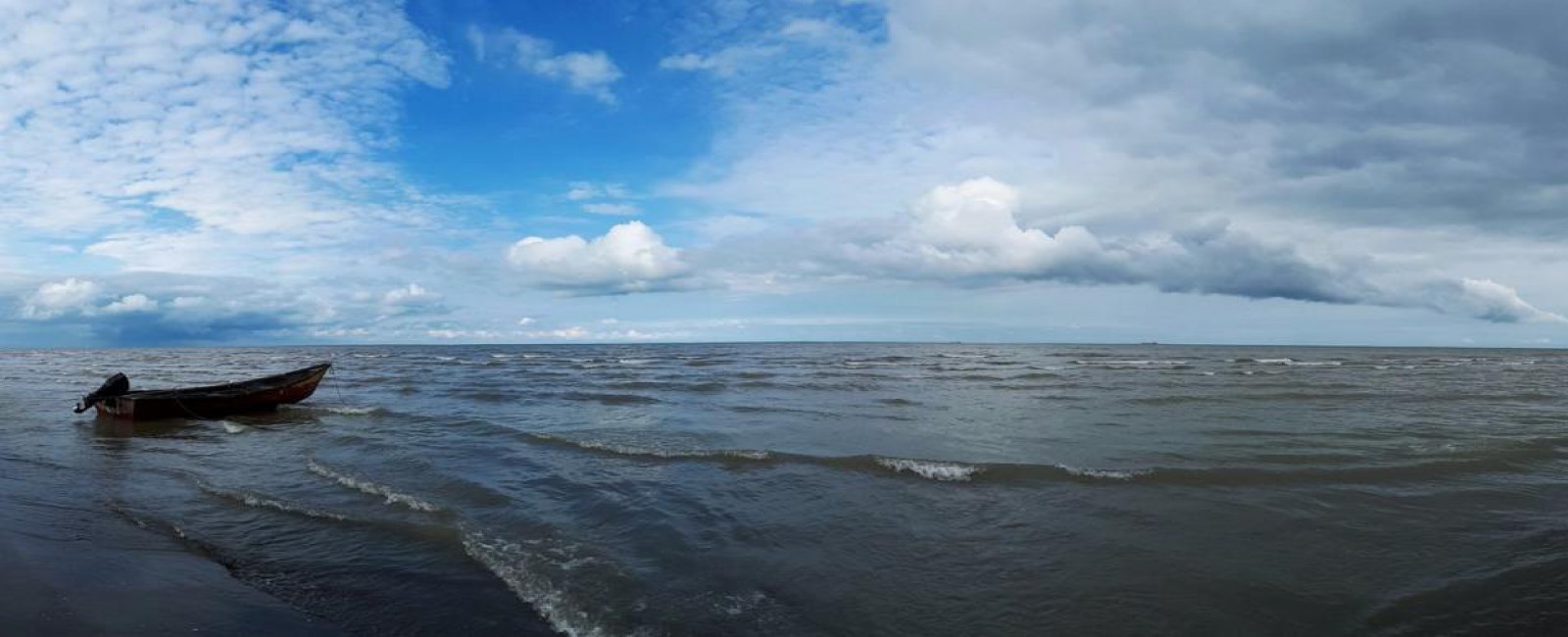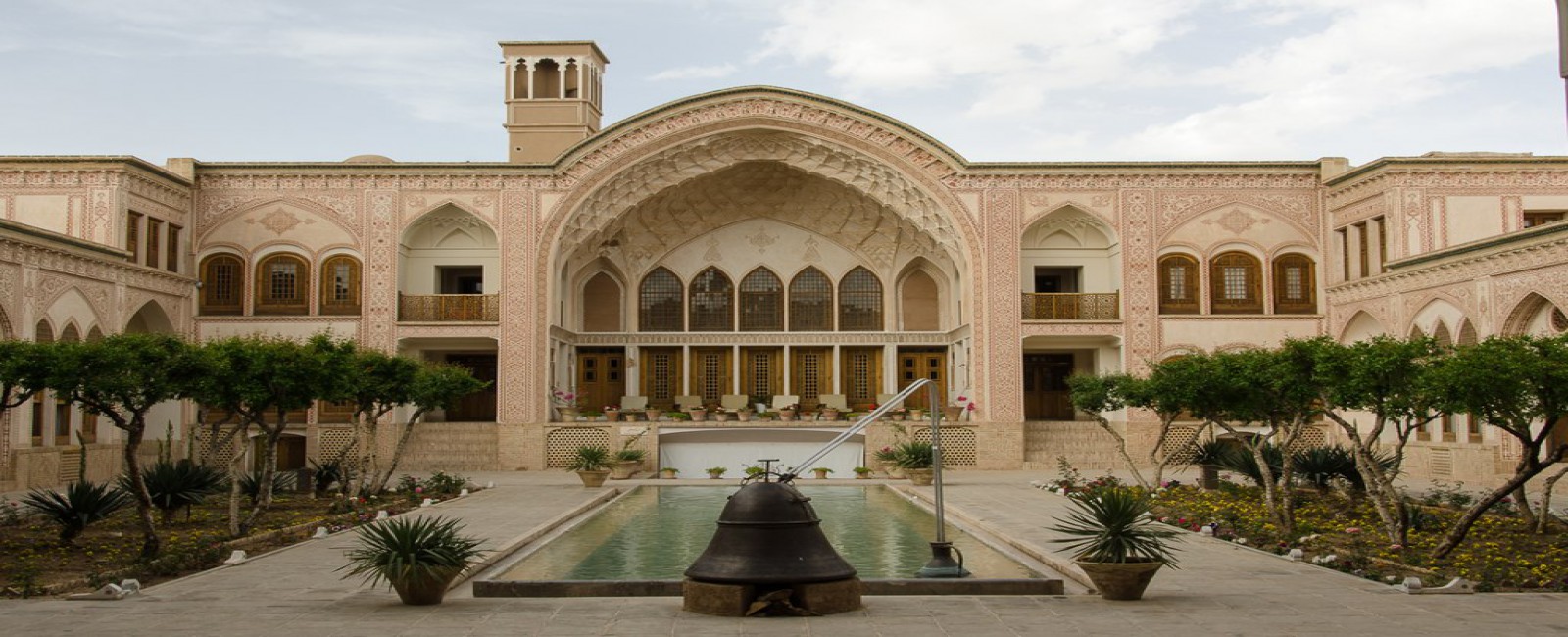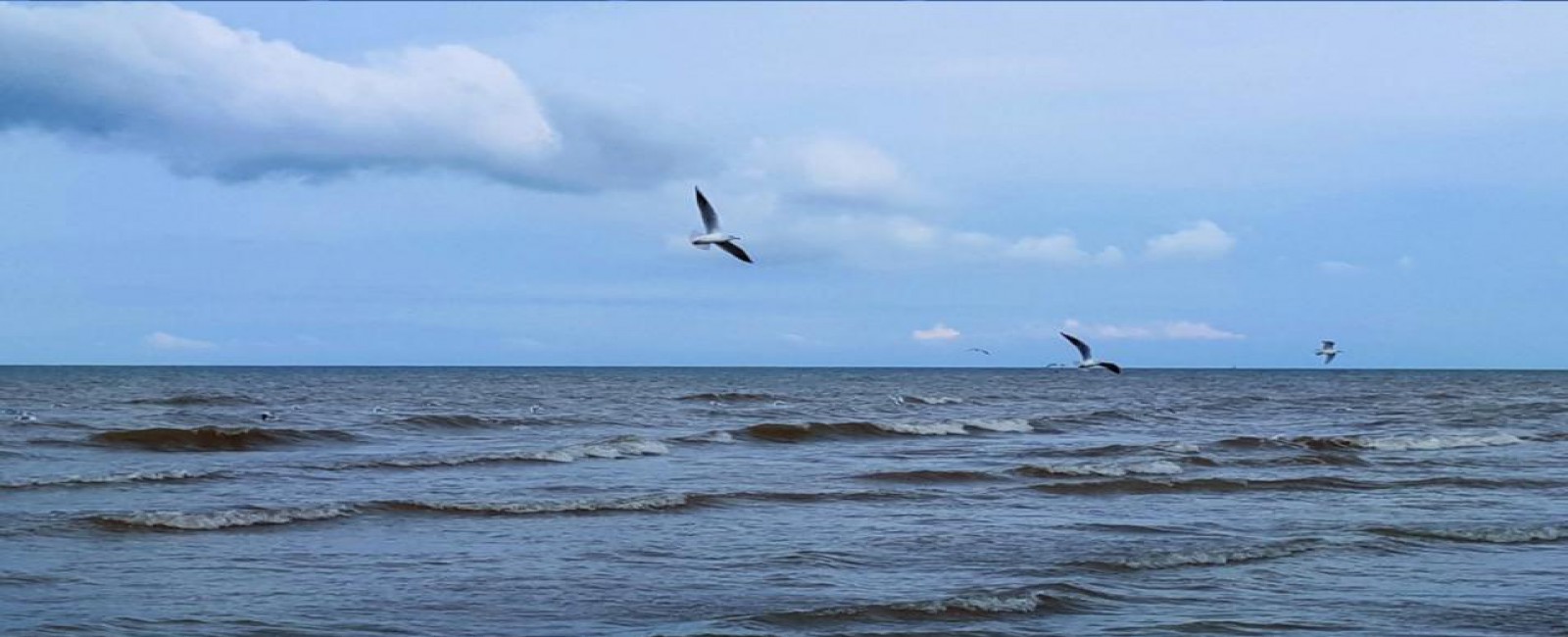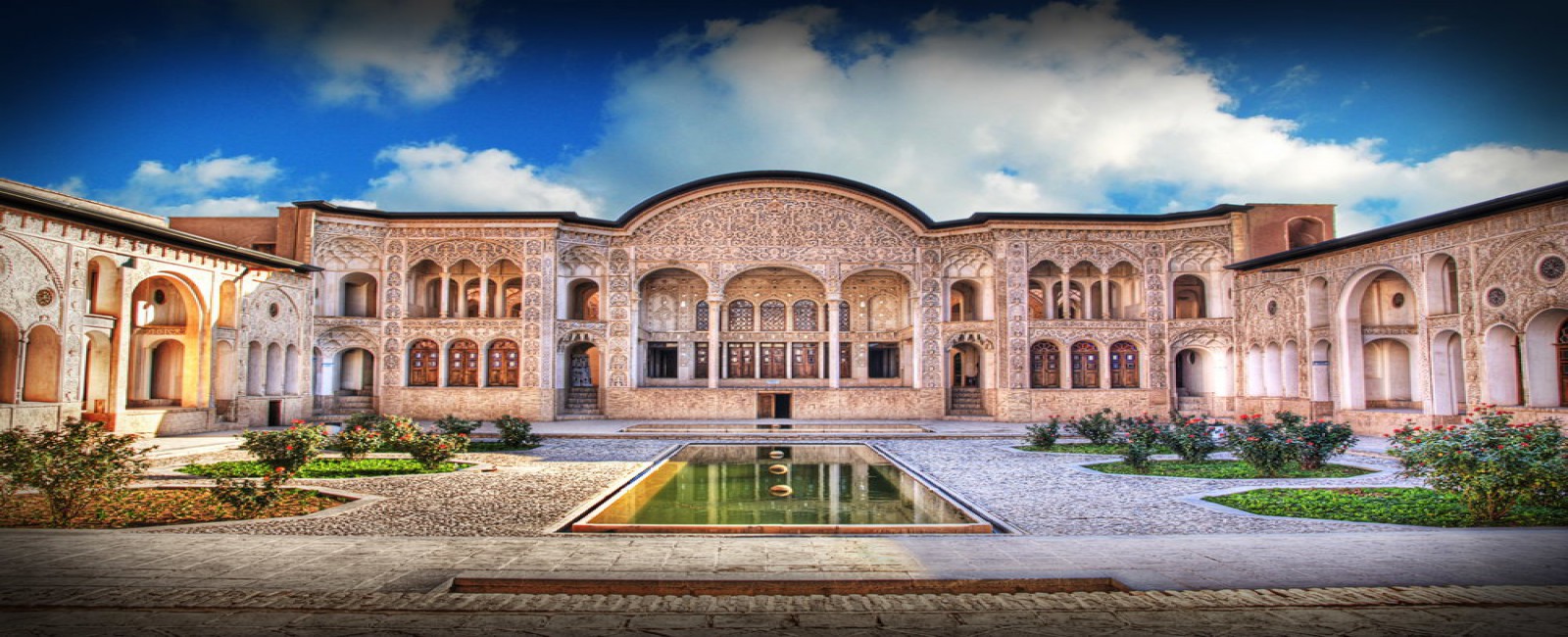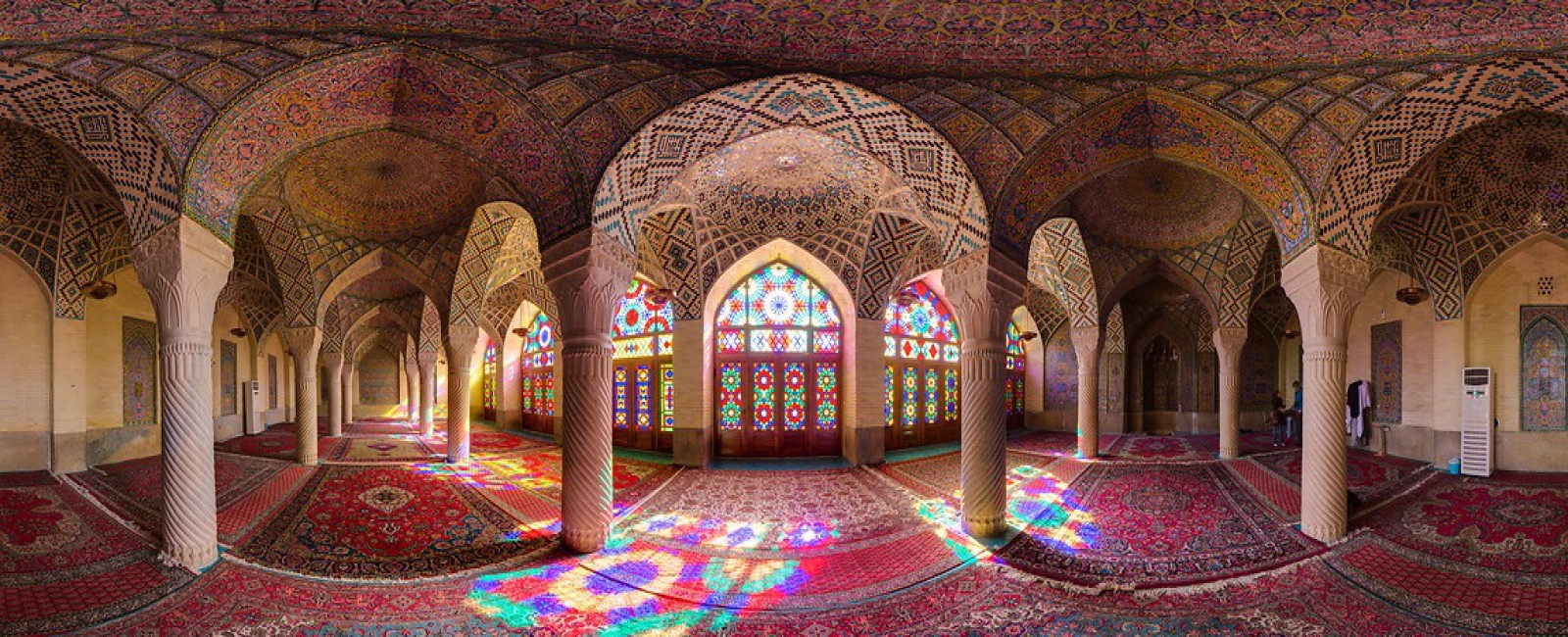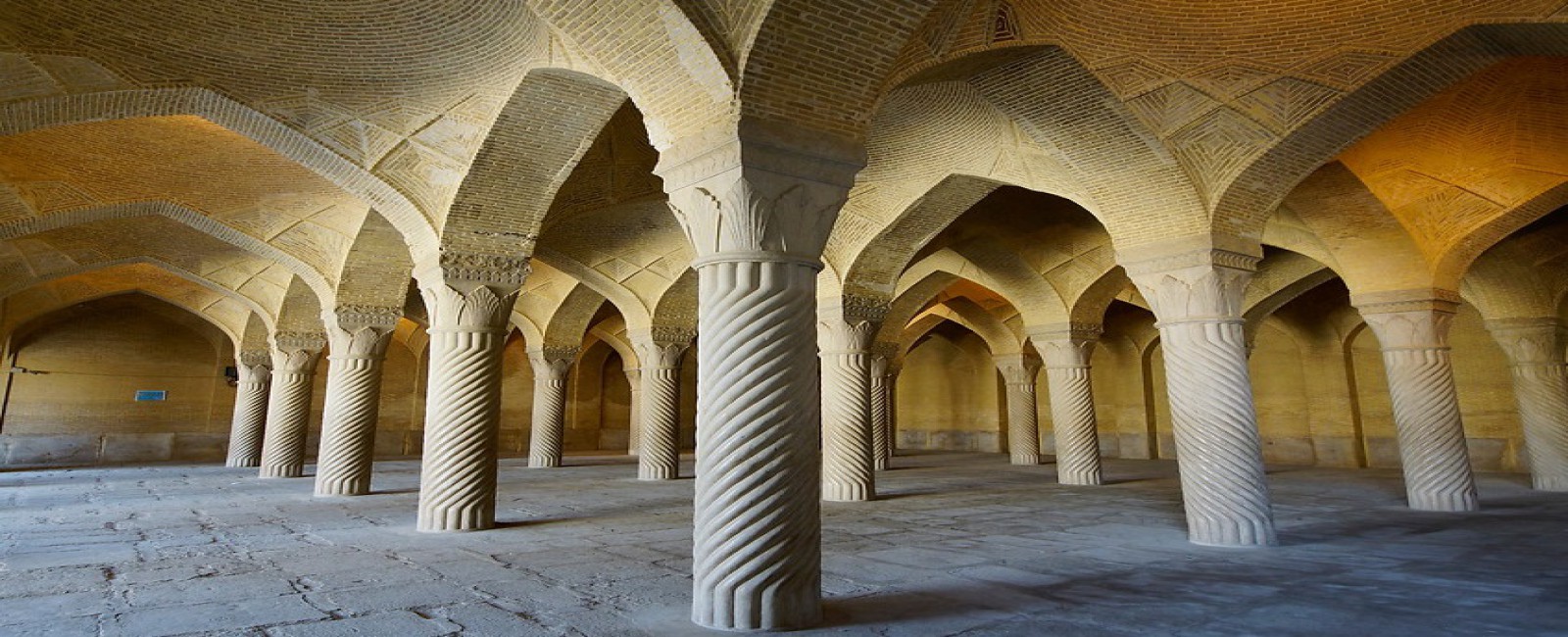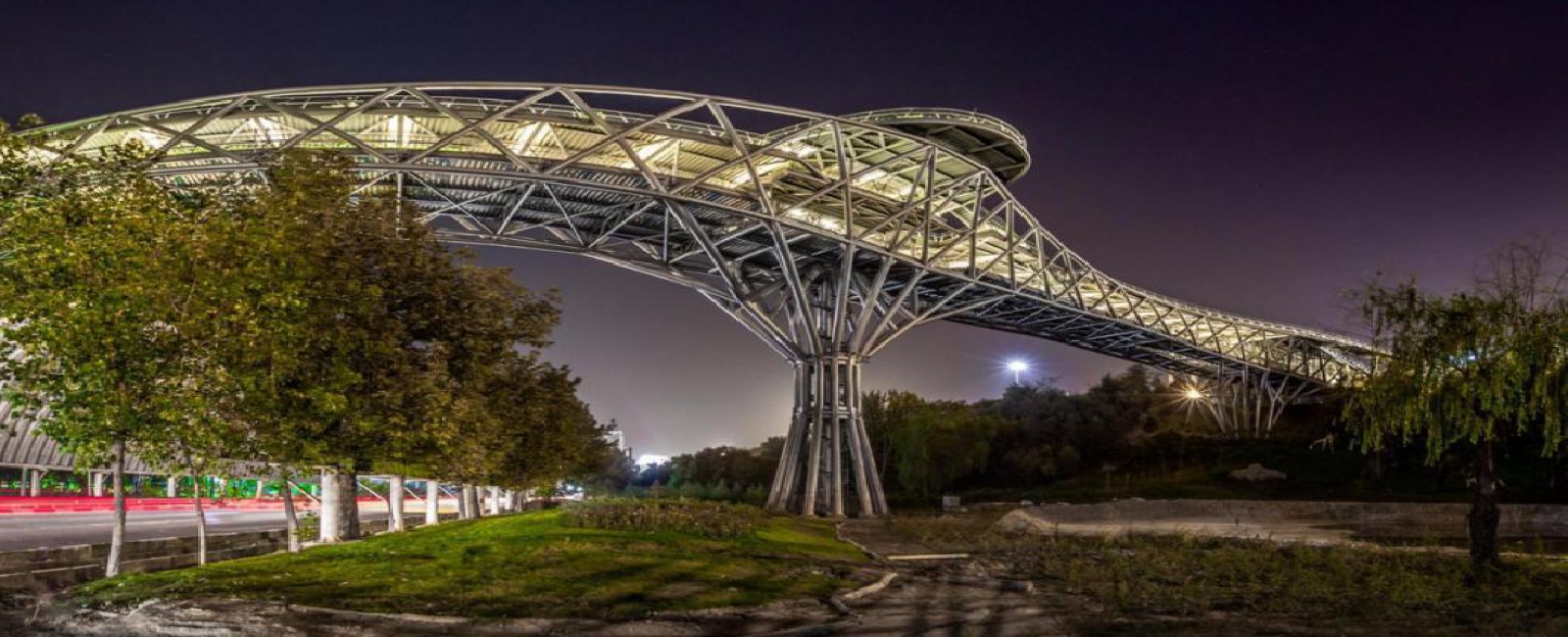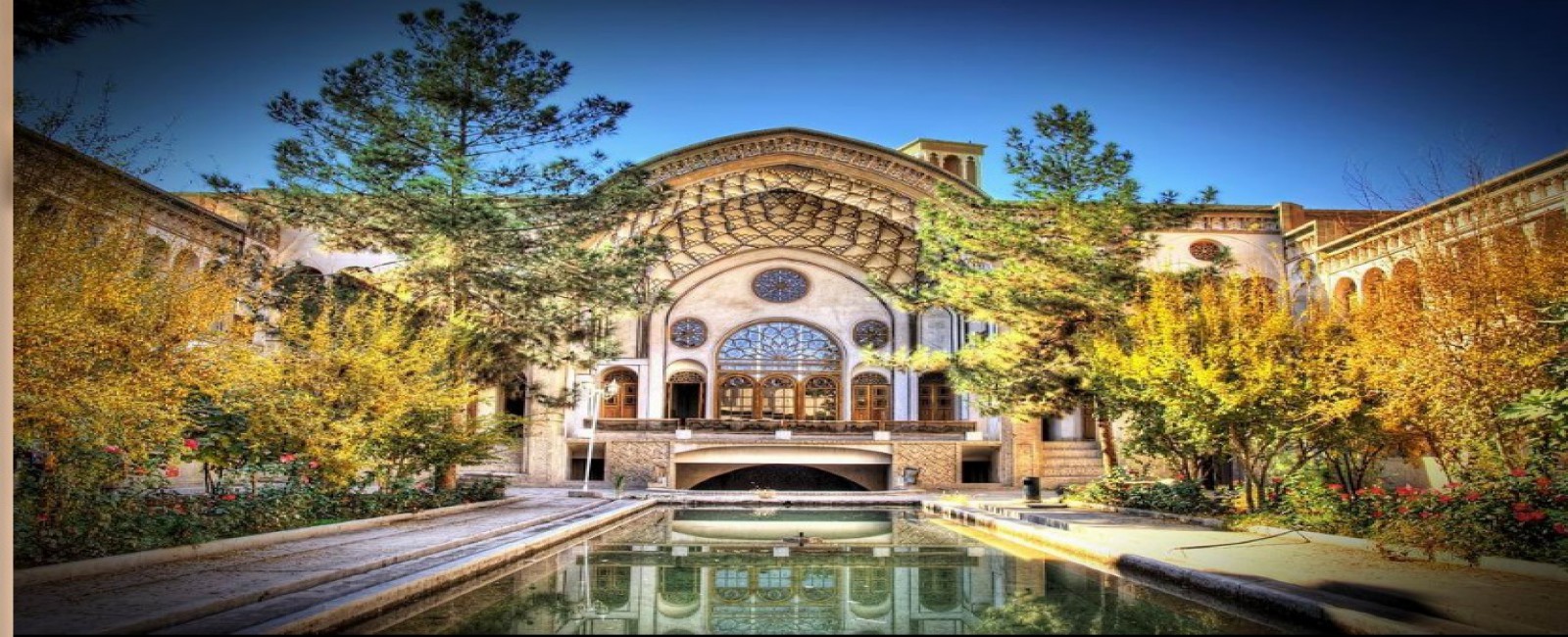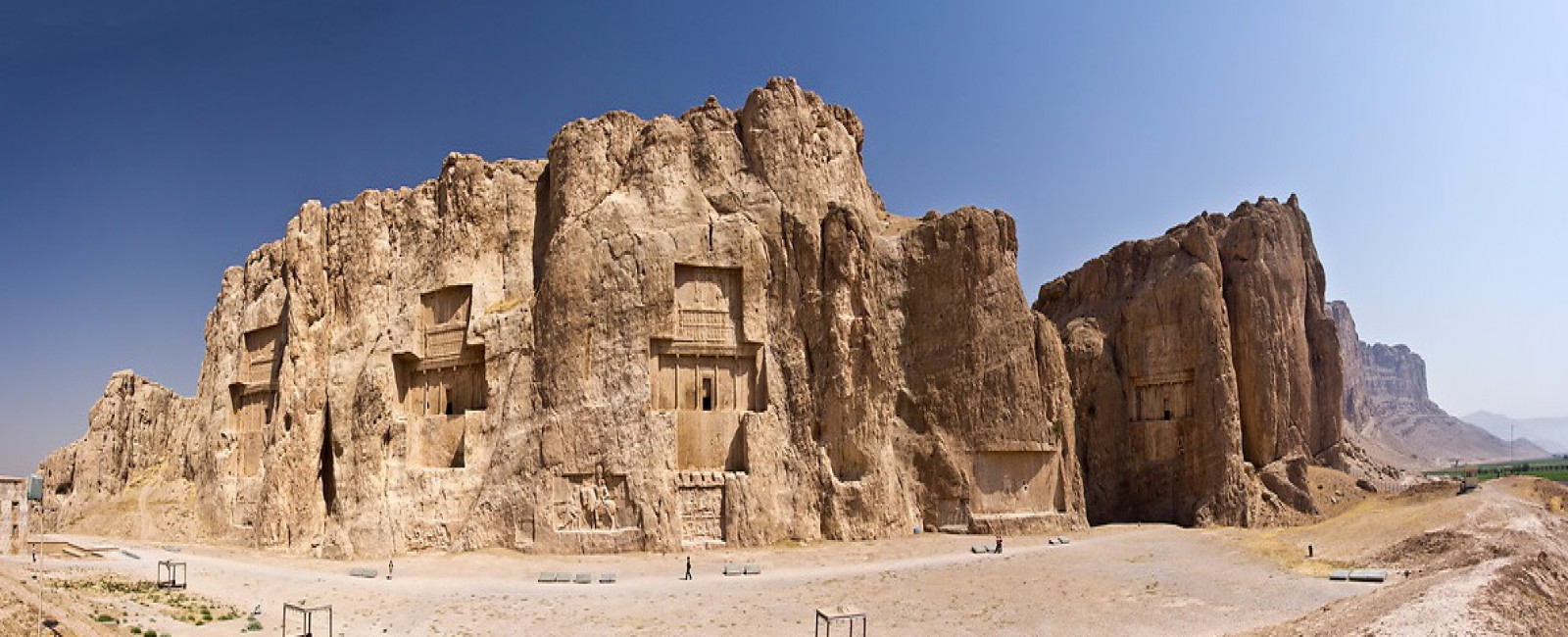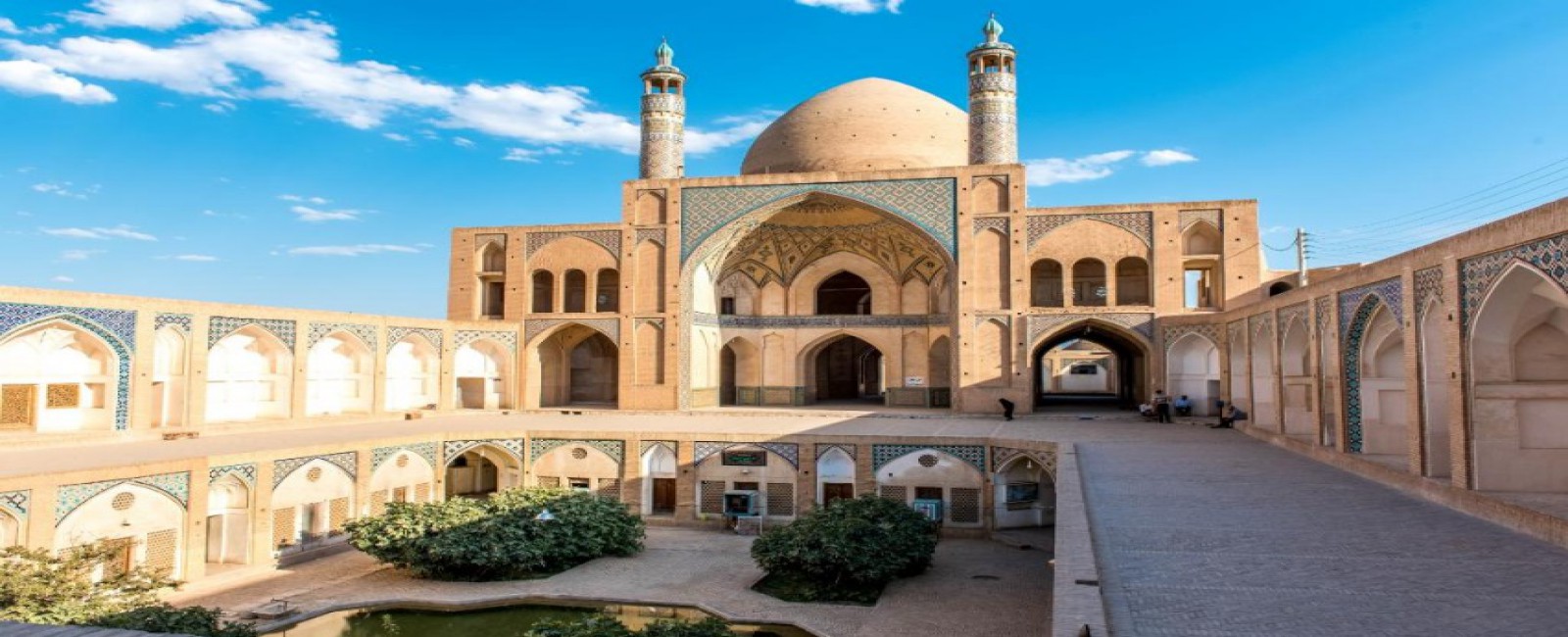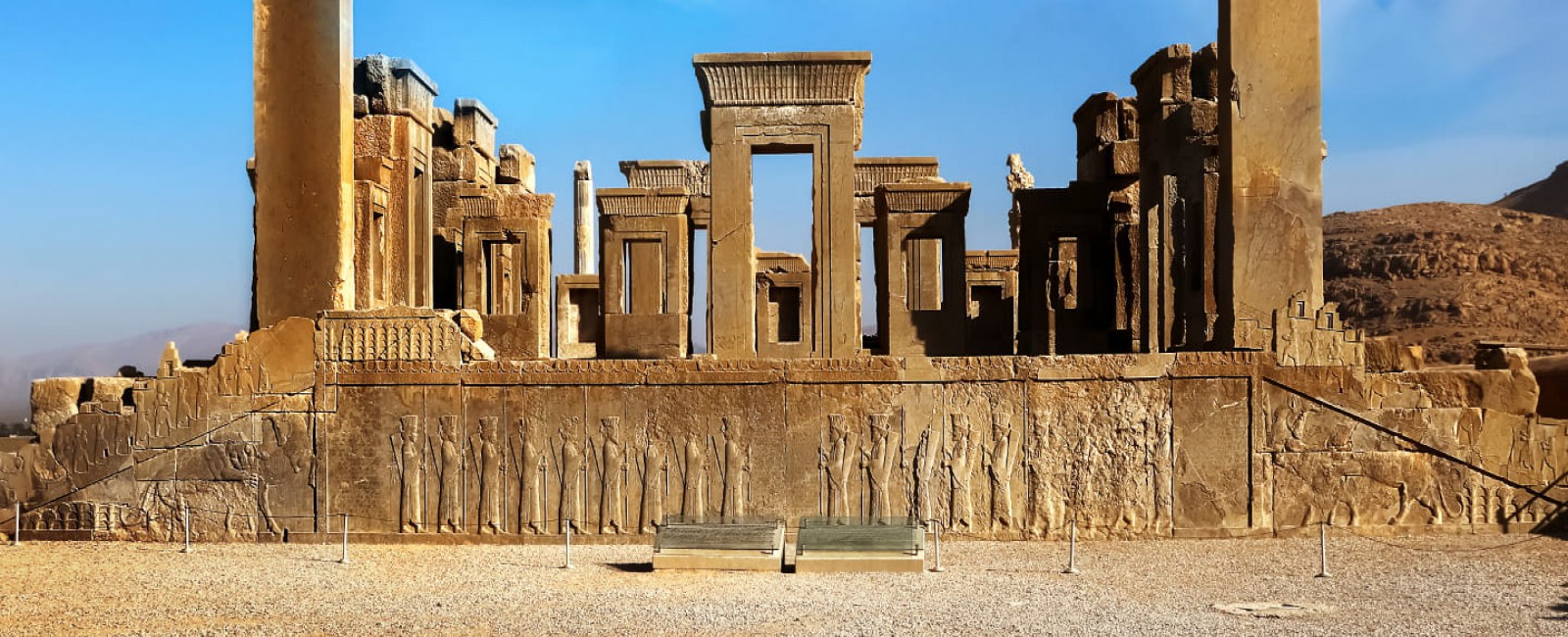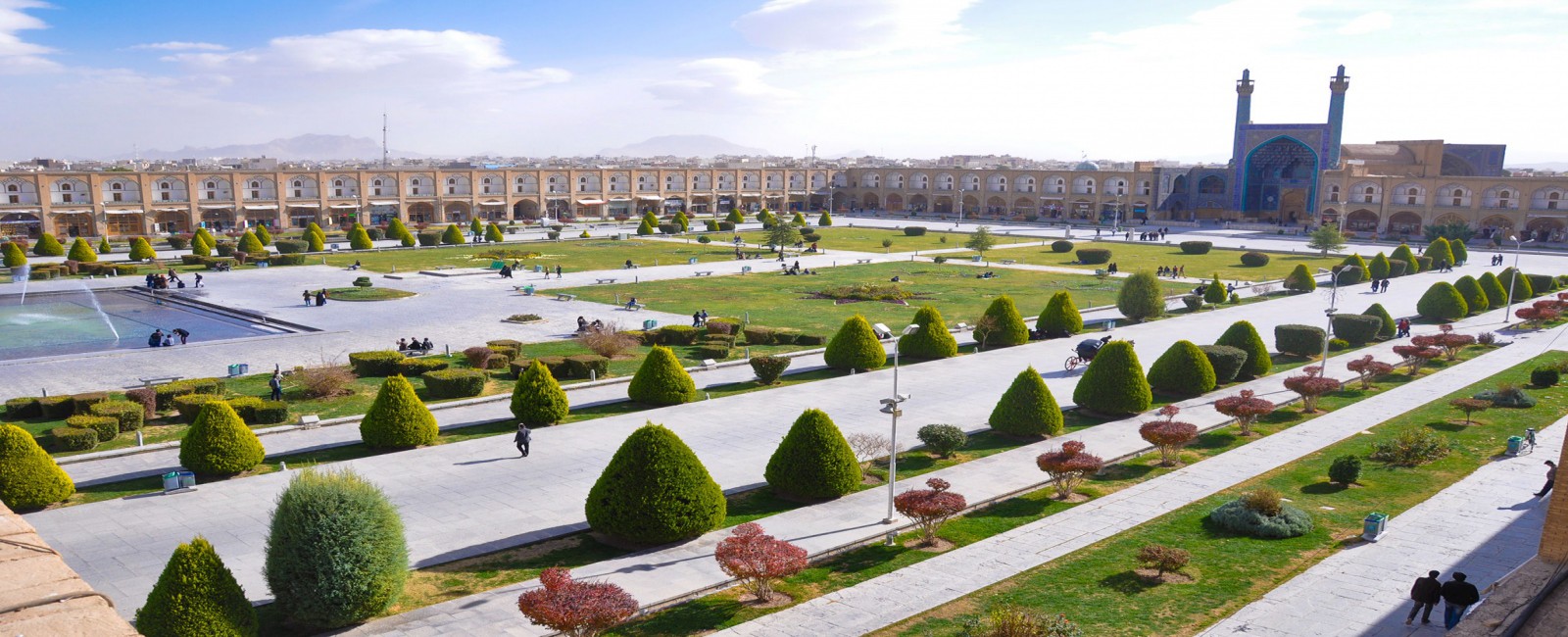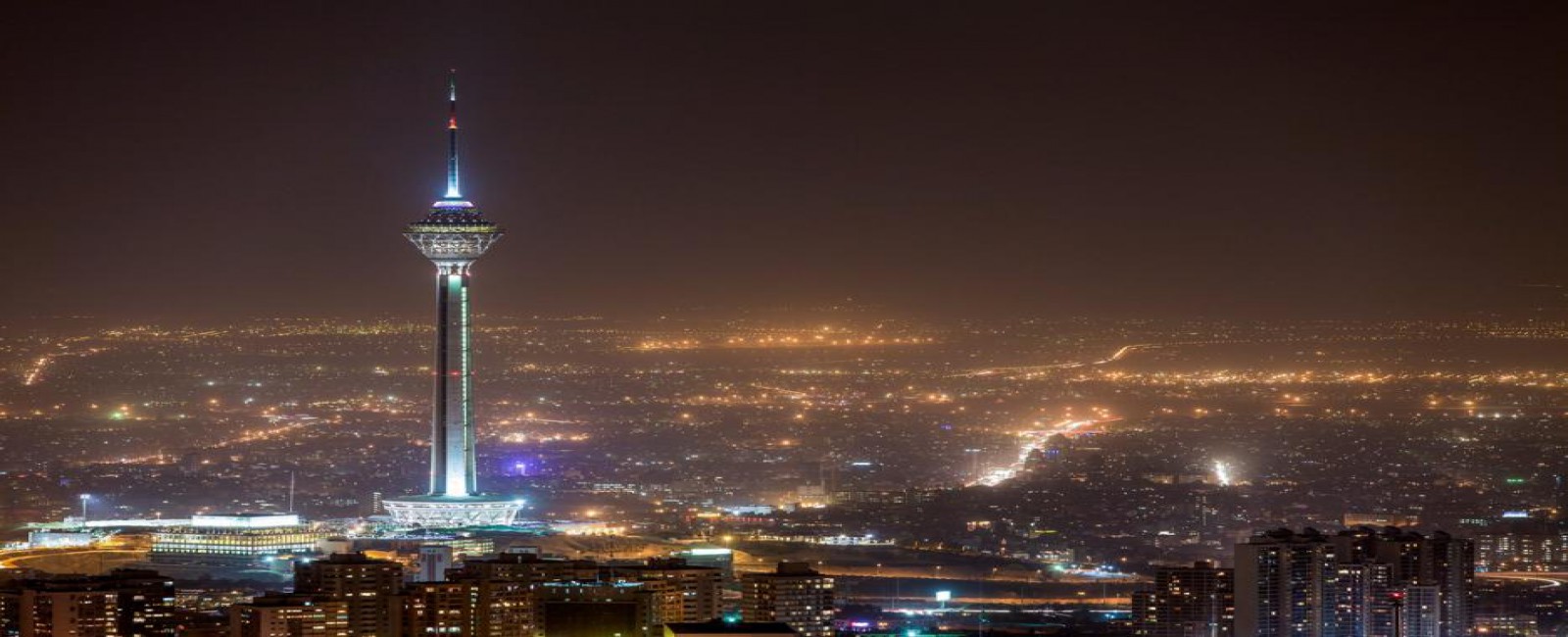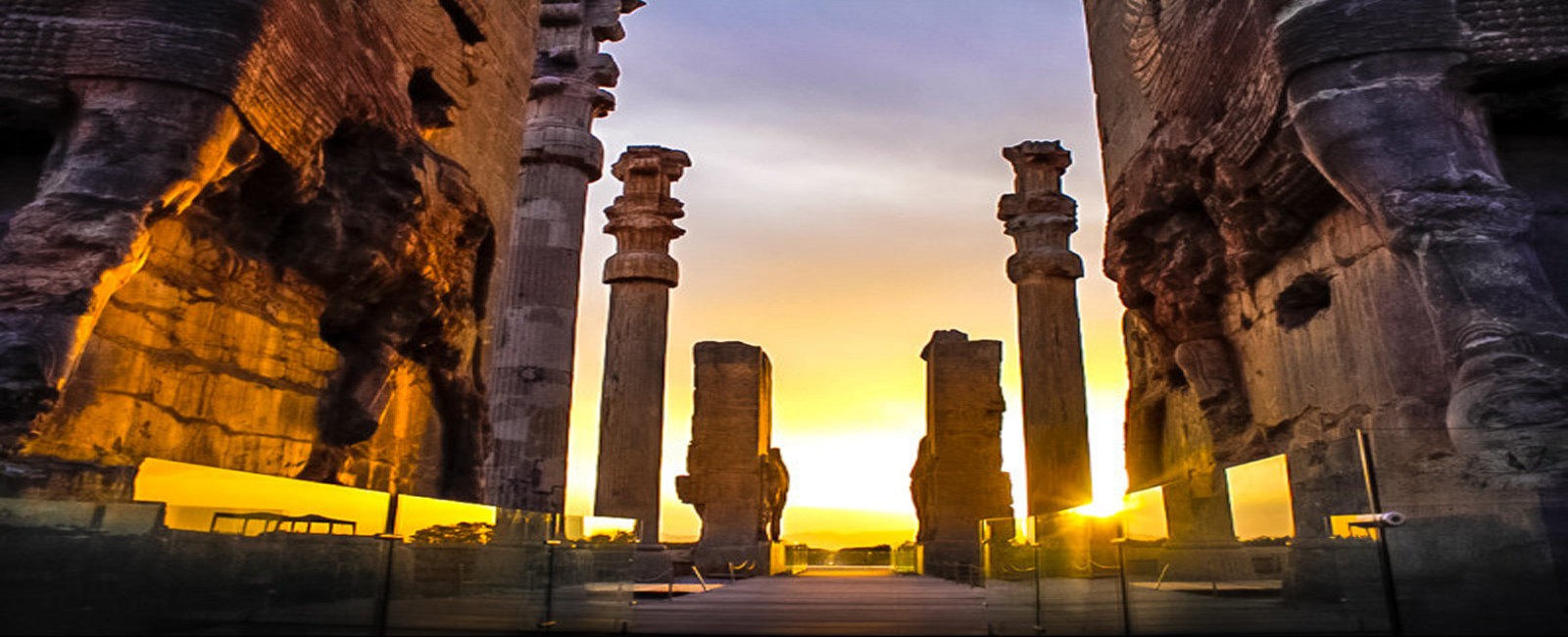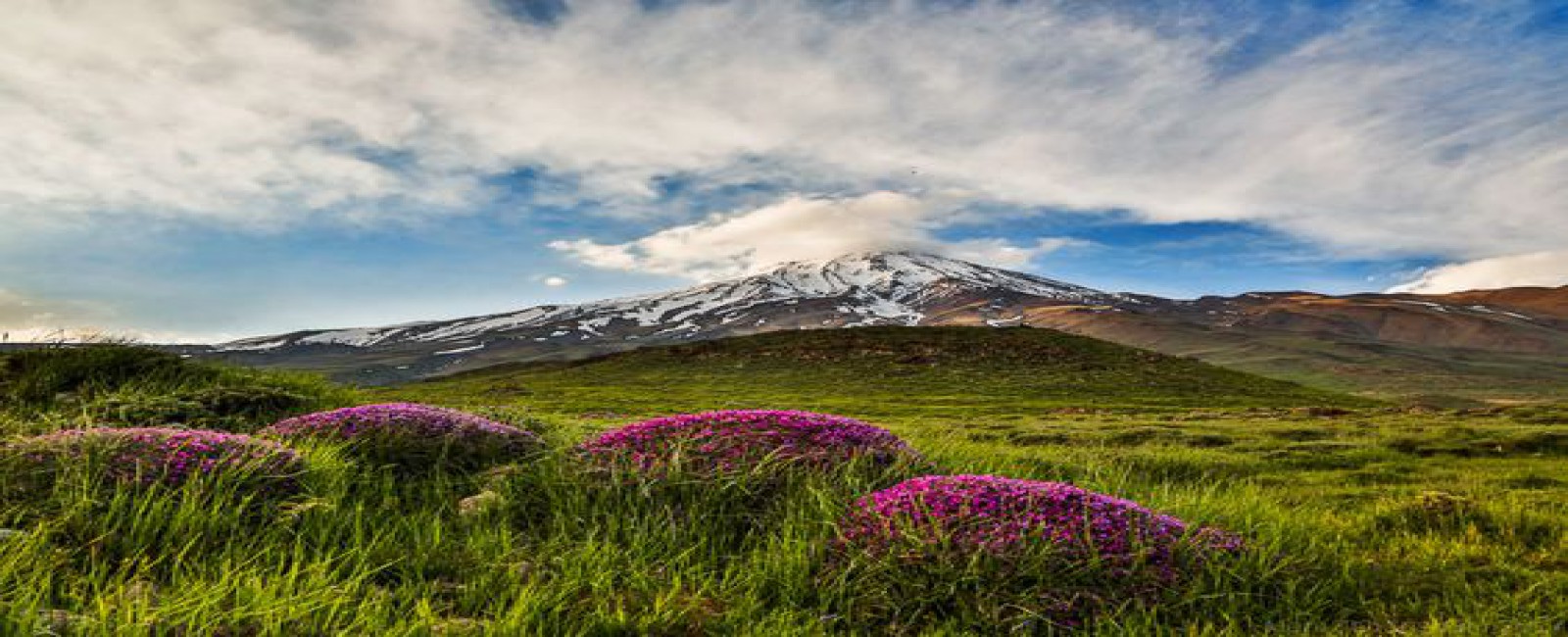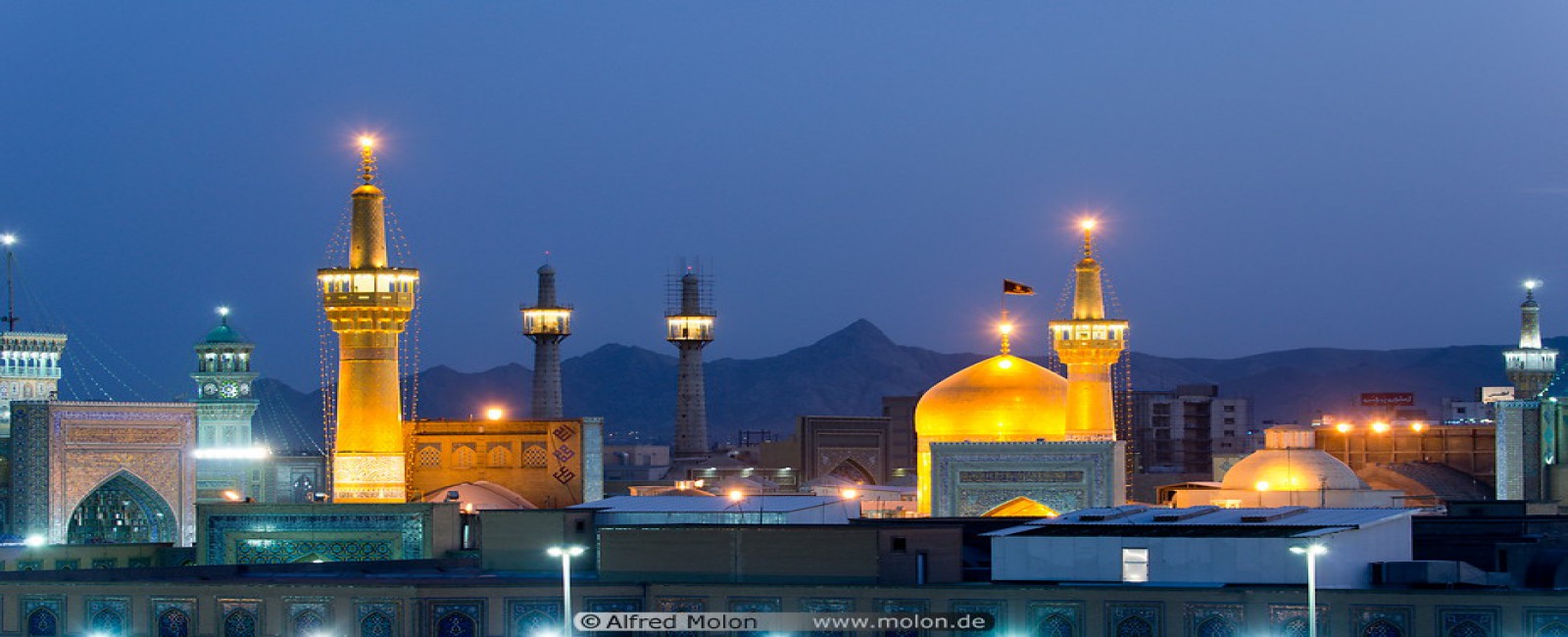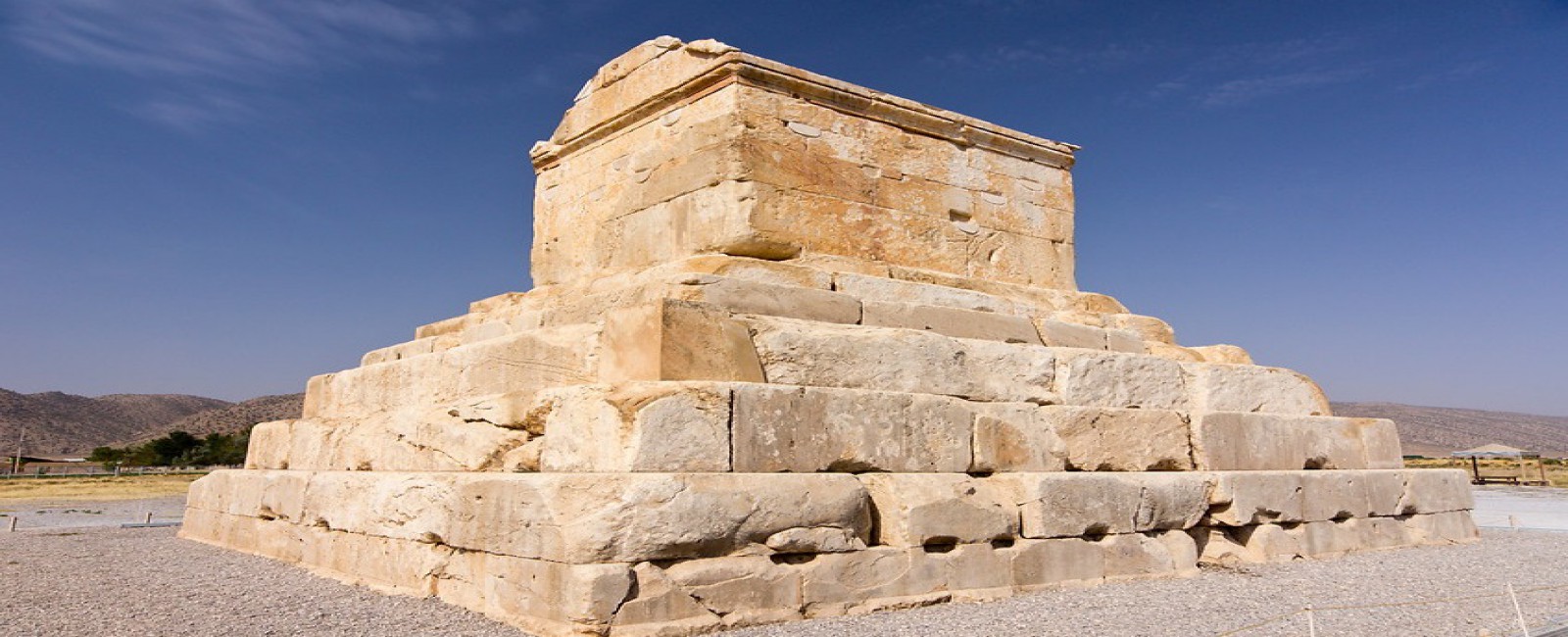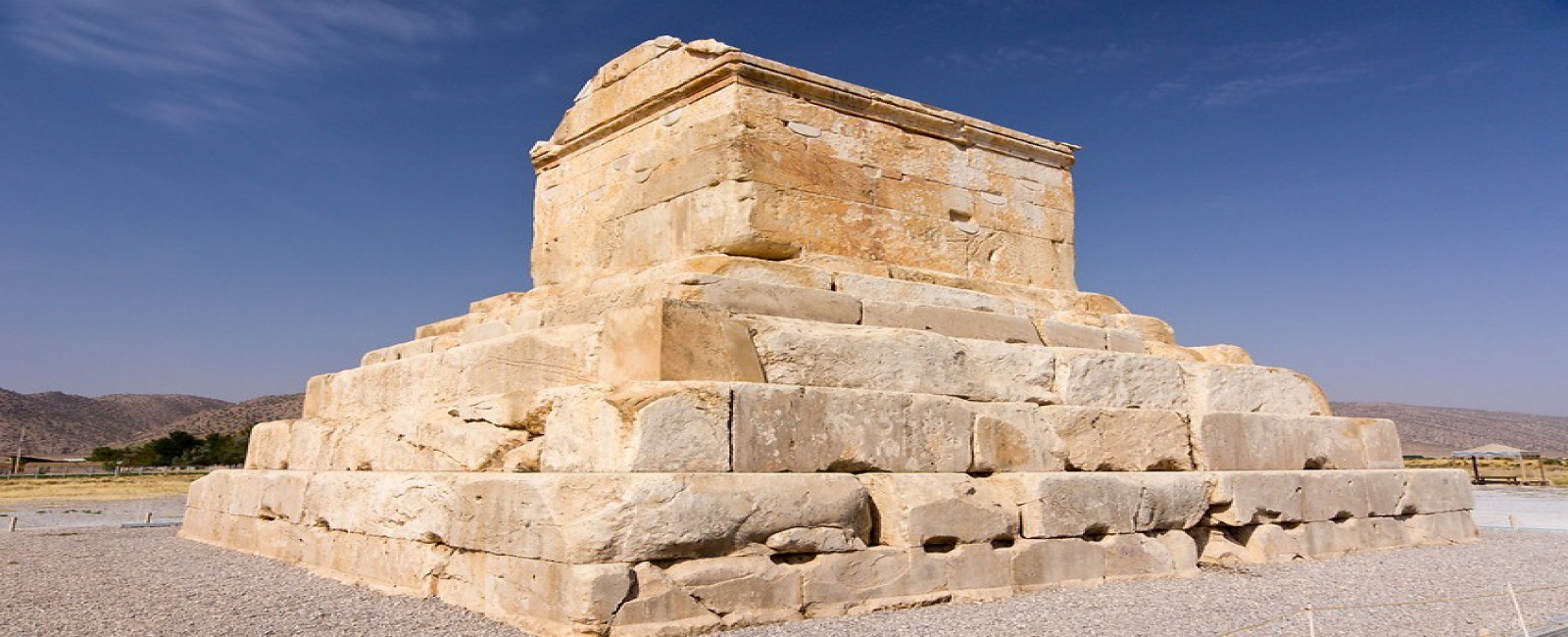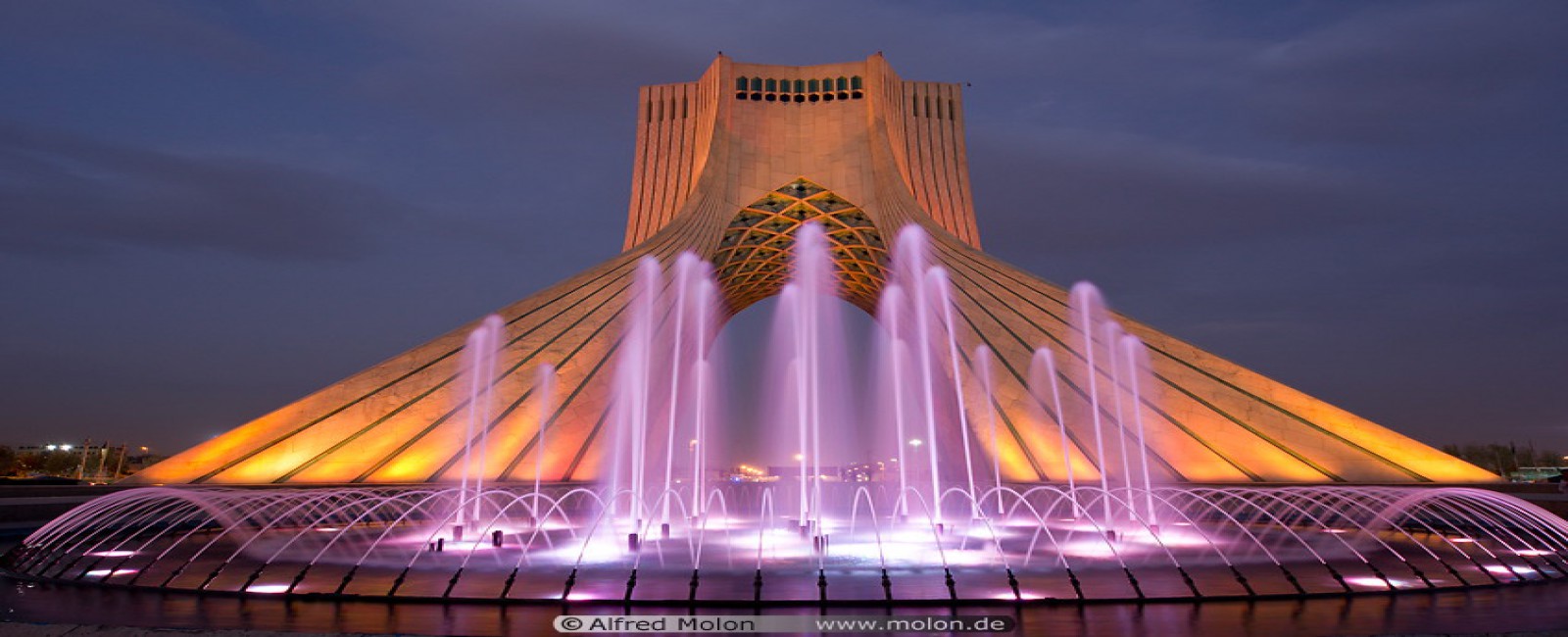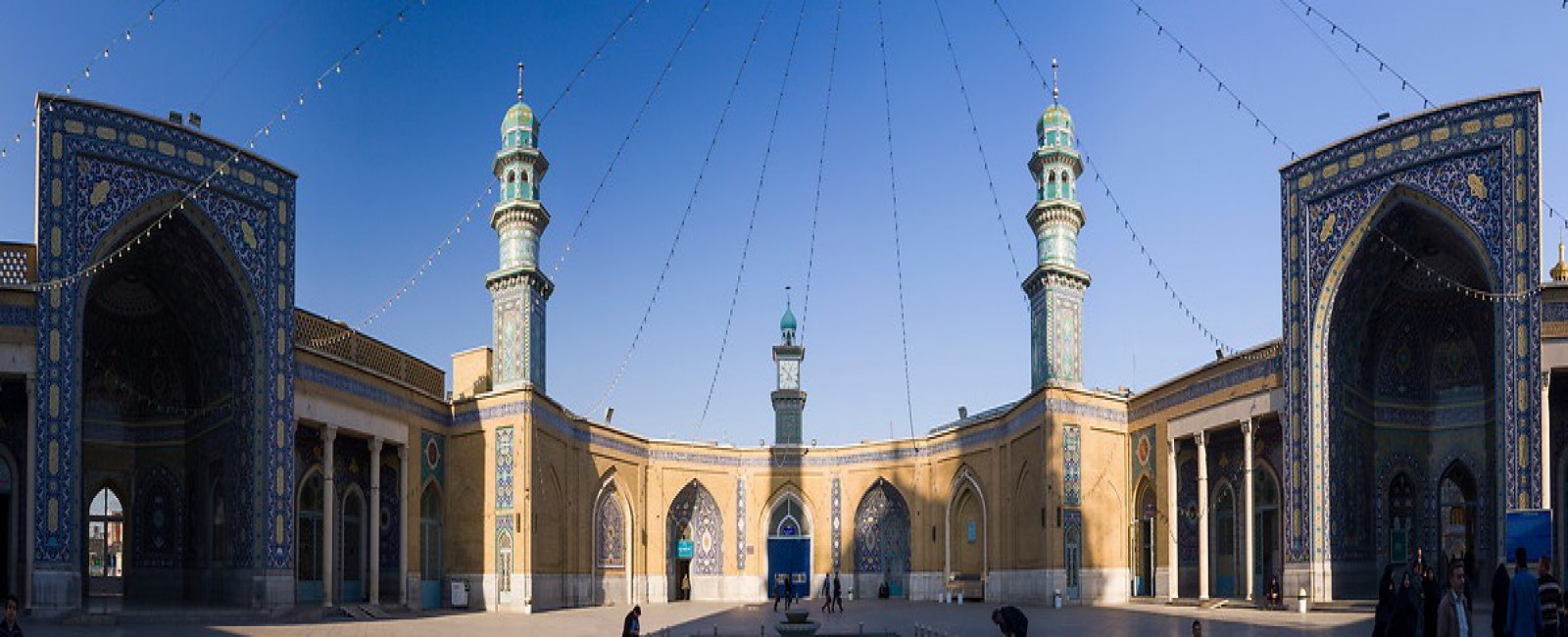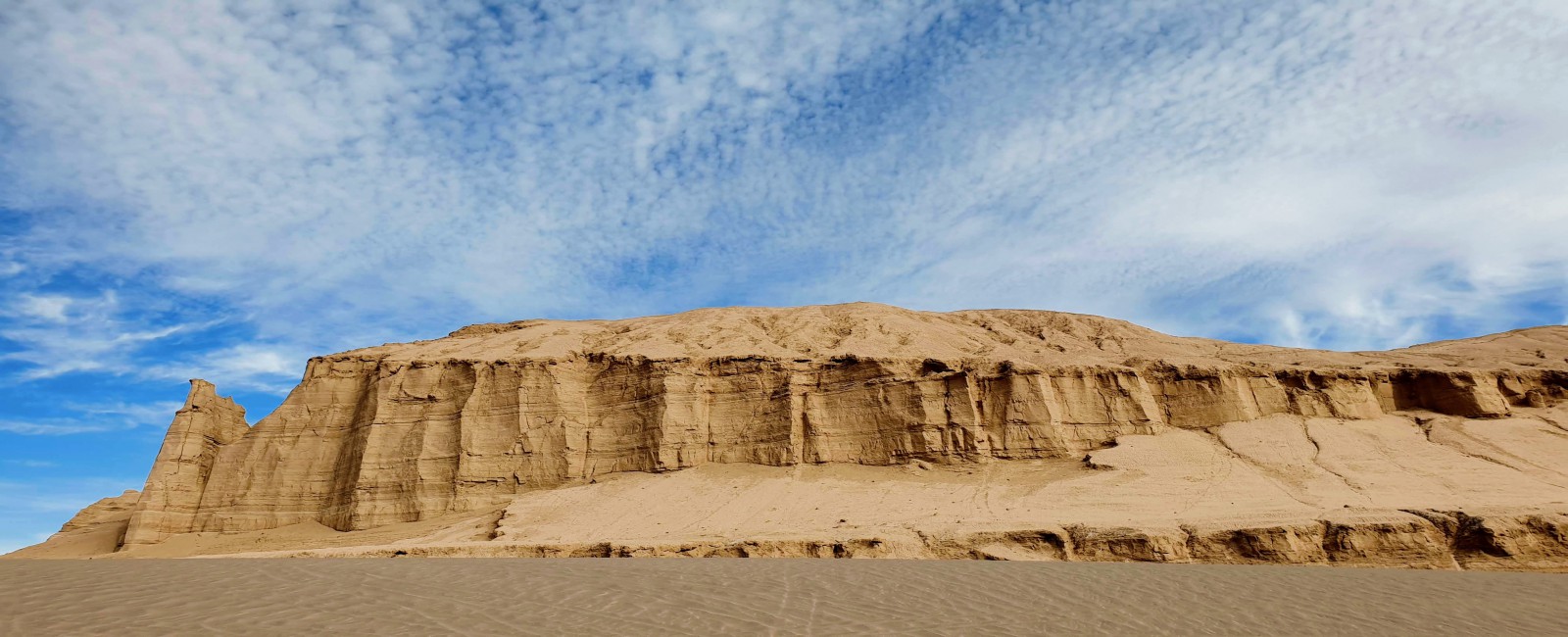Sheikh Attar Nayshaburi Tomb, Nayshabur

Faridodin Abu Hamed Mohammed-ebne-Abu Bakr Ebrahim Ben Issaq Attar Nayshaburi, the great poet and Gnostic of Iran was born around the year 540 AH and expired in 618 AH. The tomb of this famous poet is located 6 km. west of Nayshabur , near Imamzadeh Mahrooq and the tomb of Khayam . This structure is octagonal in shape with a tile worked onion shaped dome. It has 4 entrances, the northern one is the main entrance. This historical structure has been tastefully adorned with colored (green, yellow and blue) tiles and carvings. The interior site is covered by plaster and has four seats.The Mausoleum is located in a garden covering an area of about 119 sq. m. The grave of the well known painter Kamalol Molk is also situated in a part of this garden.
Kalat-e-Nadery Complex, Kalat, Mashad

The walls of Kalat are 35 km. in length and 10 km. in width and located 180 km. north of Mashad . The remains of this area belong to the Nader Shah period. There are observation towers (constructed in the years 1155-1160 AH) around this city. Existing inscriptions are evident including one written in the Turkish language and Nasta'liq script.The ancient entrance gate, Dahcheh gate, Choob Bast gate, Gashtaneh gate, Nafaqi gate located in Band-e-Arqavan Shah and Khorshid palace located in band-e-Nafaqi and Takhte-e-Dokhtar situated on a hill near the Nafaqi Gate which was built under the orders of Nader Shah are counted as the only monuments which have been remained.
Qiasieh (Khargard) School, Khaaf

This school dates back to the 9th century AH and is located in the village of Khargard ( Khaaf ). The founder of this school was Khajeh Qiasodin Pir Ahmad Khaafi, the minister of Sultan Shahrokh Bahador Teimoori.
The architects of this structure were Ostad Qavamedin and Qiasedin Shirazi. This square building consists of four terraces, the entrances of which are 4.5 m. in width and 11 m. high. This is a double storey building with 32 rooms, decorated with stone, marble and tiles.
The architects of this structure were Ostad Qavamedin and Qiasedin Shirazi. This square building consists of four terraces, the entrances of which are 4.5 m. in width and 11 m. high. This is a double storey building with 32 rooms, decorated with stone, marble and tiles.
Binalood and Aladaq Mountains, Nayshabur

These mountain ranges are the continuation of the Alborz Mountain Range. The Aladaq running 170 km. at a stretch, lies between the Koorkhod Mountains to the west, and Binalood Range to the east. From the north the Aladaq Range is limited by the Atrak Valley and to the south it stretches out towards Esfarayen and Jajrum. The highest peak of this range called Shah Jahan width is 3,032 m. in height and the distance between the two cities of Quchan and Sabzevar forms its utmost limits, that is, the Aladaq and Binalood Ranges. At this point the Binalood Mountains span a distance of 120 km. and separate the Kashaf Valley in the north from the plains of Nayshabur in the south. The Binalood peak with the height of 3,410 m. stands northwest of Nayshabur. To the south of Mashad city the hills of Fariman and Torbat Jaam stretch in continuation to The Binalood Ranges. In this area, the Binalood Mountains segregate the Kashaf Rood Valley from the Torbat-e-Jaam region and has a peak of 2,256 m. in height. In spring and summer this region forms an excellent spot, full of natural enhancements.
Astan-e-Qods Razavi Aggregate, Mashad

This forms the axis of the holy city of Mashad and is one of the most important and greatest ‘aggregates’ in the world of Islam. Its importance is due to the presence of the shrine of His Holiness Imam Reza (AS), 148-203 AH, which contains valuable historical and artistic monuments from various centuries. History of Construction :
In the year 203 AH, or as it is said, in the year 202 AH, after the martyrdom of His Holiness Imam Reza (AS), the sacred body was laid to rest on the tomb of Haroon-ol Rashid. It is said that Moqadasi was the first person to name the place Mashad (meaning the place of martyrdom). Ibn-e-Hogol has also called it ‘Mashad-ol-Reza’. In the years 366-387 AH the biased Sabkat Keen one of the rulers of the Qaznavi era, brought down the Holy Shrine to ruins and forbade pilgrimage to the sacred place. Thence, Abaidodowleh Fa'eq endeavored to complete the task of rebuilding the mausoleum and has made great efforts in making the city of Mashad flourish.Thereafter Sultan Mohammad Qaznavi built a brick wall on the former mud caked wall and erected a minaret as well.
According to the inscription in the museum of the shrine it seems that the building was repaired again in 516 AH. In the year 548 AH, the mausoleum was heavily damaged due to the attack of the Qazhs. During the reign of Sultan Sanjar Saljuqi 552-511 AH, the Shrine was once more repaired, and a dome built for the same. The daughter of Sultan Sanjar, (whose name and date of contribution is on record on the inscriptions) was responsible for paving the area surrounding the Shrine in geometrical and star (hexa and octagonal) shaped tiles which added to their beauty.
The reign of Kharazmshahian has also brought about various repairs and artistic measures in the mausoleum. In the year 612 AH, a beautiful embossed inscription on a caked tablet, fixed to the wall on both sides of the entrance to the Shrine, which is in the Tholth script indicates the names of ancestors of His Holiness Imam Reza (AS), originating from His Holiness Hazrat-e-Ali (PBUH).
After the attack of ‘Towli’ the son of Changis, in the year 618 AH, the mausoleum of Razavi was shattered once again, and later on Qazan Khan and Sultan Mohammad Khodabandeh Oljaito made efforts for repairs and artistic works of the Garden or (Baq) Razavi.
In the year 734 AH, Ebn-e-Batooteh a reputed historian, had made special mention of the beautiful and tile worked edifice with the silver railed shrine in his records. In the 8th century the Astan-e-Qodes was composed of the shrine, the Balasar mosque, a few smaller buildings attached to northern wall of a school.
During the reign of Shahrokh and his spouse Goharshad the aggregate made great progress and vast development was noted. The Goharshad mosque was erected to the direction of the kiblah of the shrine. Then buildings known as Darolhefaz, Darolsiadeh and Tahvil Khaneh (treasury) were erected. Three schools by the names of Parizad, Balasar and Dodar were also erected during this epoch. Due to the endeavors of Amir Alishir Navai the old courtyard, and the basis of the Evan-e-Tala or golden portico came into focus. Further more, in the period of Shah Abbas I it was extended to a great deal. Shah Tahmasb Safavid repaired the minaret near the dome which was then gold plated. But unfortunately due to the attack of the Ozbaks, these ingots of great value were plundered, an in the year 1010 AH, Shah Abbas ordered the repairs of this edifice. This decree is on one of the carvings by the famous calligrapher Ali Reza Abbasi. It should be brought to attention that the said mausoleum vastly expanded due to additions during the passage of time-such as the Ravaq or Porch of Towhid Khaneh (to the north of the shrine) is by the efforts of Molla Mohsen Faiz, Ravaq-e-Allahverdi Khan and Ravaq-e-Hatam Khani are likewise erected by Allahverdi Khan and Hatem Bek Ordubadi. Shah Abbas II was responsible for the repairs of the Attiq courtyard which was inlayed with tiles and Shah Soleiman gave orders for the repair of the dome of the holy shrine which had a crack due to an earthquake. In addition to which, many schools were built during his reign.
In the period of Nader Shah Afshar areas of the mausoleum, such as the Golden Porch, the Attiq Courtyard and the minaret standing on it were repaired and gold plated.
Constitutions of the new courtyard were began in the reign of Fathali Shah Qajar and were completed in the reign of Naseredin Shah. According to the orders issued by Naseredin Shah, the walls were raised to the height of the Naseri portico, and the arched ceiling of which were covered with ingots. Mozafarudin Shah made his contributions in having the two courtyards repaired.
In the year 1330 AH, the Russian forces brought about plenty of destruction to this aggregate, but in the year 1307 AH, vital changes were noted in this regard. The museum, library and the hall of protocol were constructed around the network. In the year 1350 AH, the old historical textures were demolished giving way to parks and greenery. Presently, changes and innovations are dominant in the area. The current aggregate consists of the shrine porticos, courtyard, schools, porches, dome, minarets, museum, library and other relative assets.
In the year 1330 AH, the Russian forces brought about plenty of destruction to this aggregate, but in the year 1307 AH, vital changes were noted in this regard. The museum, library and the hall of protocol were constructed around the network. In the year 1350 AH, the old historical textures were demolished giving way to parks and greenery. Presently, changes and innovations are dominant in the area. The current aggregate consists of the shrine porticos, courtyard, schools, porches, dome, minarets, museum, library and other relative assets.
Other important factors of this aggregate are the sacred shrine, its old courtyards, the Imam Khomeini courtyard, and various other courtyard such as the Qods and Jomhuri-e- Islami. Porches or Ravaqs such as Darolsiadeh, Darolziafeh, Darolzekr and Darolsoroor to name a few. Towhid Khaneh, Hatam Khani, Allahverdi Khan and the Balasar Mosque all come under this aggregate.
In the year 203 AH, or as it is said, in the year 202 AH, after the martyrdom of His Holiness Imam Reza (AS), the sacred body was laid to rest on the tomb of Haroon-ol Rashid. It is said that Moqadasi was the first person to name the place Mashad (meaning the place of martyrdom). Ibn-e-Hogol has also called it ‘Mashad-ol-Reza’. In the years 366-387 AH the biased Sabkat Keen one of the rulers of the Qaznavi era, brought down the Holy Shrine to ruins and forbade pilgrimage to the sacred place. Thence, Abaidodowleh Fa'eq endeavored to complete the task of rebuilding the mausoleum and has made great efforts in making the city of Mashad flourish.Thereafter Sultan Mohammad Qaznavi built a brick wall on the former mud caked wall and erected a minaret as well.
According to the inscription in the museum of the shrine it seems that the building was repaired again in 516 AH. In the year 548 AH, the mausoleum was heavily damaged due to the attack of the Qazhs. During the reign of Sultan Sanjar Saljuqi 552-511 AH, the Shrine was once more repaired, and a dome built for the same. The daughter of Sultan Sanjar, (whose name and date of contribution is on record on the inscriptions) was responsible for paving the area surrounding the Shrine in geometrical and star (hexa and octagonal) shaped tiles which added to their beauty.
The reign of Kharazmshahian has also brought about various repairs and artistic measures in the mausoleum. In the year 612 AH, a beautiful embossed inscription on a caked tablet, fixed to the wall on both sides of the entrance to the Shrine, which is in the Tholth script indicates the names of ancestors of His Holiness Imam Reza (AS), originating from His Holiness Hazrat-e-Ali (PBUH).
After the attack of ‘Towli’ the son of Changis, in the year 618 AH, the mausoleum of Razavi was shattered once again, and later on Qazan Khan and Sultan Mohammad Khodabandeh Oljaito made efforts for repairs and artistic works of the Garden or (Baq) Razavi.
In the year 734 AH, Ebn-e-Batooteh a reputed historian, had made special mention of the beautiful and tile worked edifice with the silver railed shrine in his records. In the 8th century the Astan-e-Qodes was composed of the shrine, the Balasar mosque, a few smaller buildings attached to northern wall of a school.
During the reign of Shahrokh and his spouse Goharshad the aggregate made great progress and vast development was noted. The Goharshad mosque was erected to the direction of the kiblah of the shrine. Then buildings known as Darolhefaz, Darolsiadeh and Tahvil Khaneh (treasury) were erected. Three schools by the names of Parizad, Balasar and Dodar were also erected during this epoch. Due to the endeavors of Amir Alishir Navai the old courtyard, and the basis of the Evan-e-Tala or golden portico came into focus. Further more, in the period of Shah Abbas I it was extended to a great deal. Shah Tahmasb Safavid repaired the minaret near the dome which was then gold plated. But unfortunately due to the attack of the Ozbaks, these ingots of great value were plundered, an in the year 1010 AH, Shah Abbas ordered the repairs of this edifice. This decree is on one of the carvings by the famous calligrapher Ali Reza Abbasi. It should be brought to attention that the said mausoleum vastly expanded due to additions during the passage of time-such as the Ravaq or Porch of Towhid Khaneh (to the north of the shrine) is by the efforts of Molla Mohsen Faiz, Ravaq-e-Allahverdi Khan and Ravaq-e-Hatam Khani are likewise erected by Allahverdi Khan and Hatem Bek Ordubadi. Shah Abbas II was responsible for the repairs of the Attiq courtyard which was inlayed with tiles and Shah Soleiman gave orders for the repair of the dome of the holy shrine which had a crack due to an earthquake. In addition to which, many schools were built during his reign.
In the period of Nader Shah Afshar areas of the mausoleum, such as the Golden Porch, the Attiq Courtyard and the minaret standing on it were repaired and gold plated.
Constitutions of the new courtyard were began in the reign of Fathali Shah Qajar and were completed in the reign of Naseredin Shah. According to the orders issued by Naseredin Shah, the walls were raised to the height of the Naseri portico, and the arched ceiling of which were covered with ingots. Mozafarudin Shah made his contributions in having the two courtyards repaired.
In the year 1330 AH, the Russian forces brought about plenty of destruction to this aggregate, but in the year 1307 AH, vital changes were noted in this regard. The museum, library and the hall of protocol were constructed around the network. In the year 1350 AH, the old historical textures were demolished giving way to parks and greenery. Presently, changes and innovations are dominant in the area. The current aggregate consists of the shrine porticos, courtyard, schools, porches, dome, minarets, museum, library and other relative assets.
In the year 1330 AH, the Russian forces brought about plenty of destruction to this aggregate, but in the year 1307 AH, vital changes were noted in this regard. The museum, library and the hall of protocol were constructed around the network. In the year 1350 AH, the old historical textures were demolished giving way to parks and greenery. Presently, changes and innovations are dominant in the area. The current aggregate consists of the shrine porticos, courtyard, schools, porches, dome, minarets, museum, library and other relative assets.
Other important factors of this aggregate are the sacred shrine, its old courtyards, the Imam Khomeini courtyard, and various other courtyard such as the Qods and Jomhuri-e- Islami. Porches or Ravaqs such as Darolsiadeh, Darolziafeh, Darolzekr and Darolsoroor to name a few. Towhid Khaneh, Hatam Khani, Allahverdi Khan and the Balasar Mosque all come under this aggregate.
Qadamgah Mausoleum, Mashad

This beautiful Mausoleum dates back to the 11th century AH and is octagonal shaped with tall porticos and two storeyed arches and decorated with seven colored tiles and plaster moldings. It is located in a large garden in the village of Qadamgah and has been erected by Shah Soleiman in the year 1091 AH. In this Mausoleum there is a stone tablet that bears the impression of the soles of two feet. It is said that these impressions belong to the feet of His Holiness Imam Reza (AS). The dome of this structure has been decorated with white and turquoise colored diamond shaped figures which surround the dome. An inscription which is written by Al Abd Mohammad Hossein in Thulth script can also be noted.
Torbat Sheikh Jaam Aggregate, Torbat Jaam

The pilgrimage site of Ahmad Bin Abol Hassan Sheikh Ahmad Jaam (441-536 AH.), is located in Mashad - Harat Road and consists of ten historical buildings which are placed around a vast courtyard. Sheikh Ahmad pilgrimage is one of the greatests pilgrimage centers in eastern Iran. The following belong to this aggregate:Sheikh Jaam Nameqi Tomb: This tomb is made of brick and gypsum and pilgrims of Torbat Sheikh have special belief and faith in this imminent personality. The inscriptions carved on two white stones placed on either end of the tomb display Kufi and Nasta’liq scripts. Besides which fine oriental arts can be seen on the fringes of these tablets.
Gonbad Khaneh: The Gonbad and Gonbad Khaneh are situated in the heart of this aggregate and each of its four sides are covered by the surrounding buildings.
Atiq Mosque: This mosque is located to the southwest of Gonabad Khaneh and has a domed Shabestan like a mosque which encloses five porches. Unique architectural and artistic techniques can be observed here. Plaster works, brick encarvings on plaster with a type and quiality of tiles, belonging to the architectural method of the 8th century.
Eivan (Portico): This ‘Eivan’ or portico is beautifully decorated with tiles and plaster work. It stands opposite the dome and reaches a height of approximately 30 m., the ceiling of which has semi-dome with an octamerous arch.
Kermani Mosque: This mosque consists of halls on each side of the structure, and three rooms on the western and eastern side. Arches can be noted around these rooms, as well as arched plaster molding on the upper framework of the door of these rooms. There is a beautiful altar of plaster molding in the western hall which is intricately decorated wih floral and geometrical designs. These works of art are of great value. The facade of this mosque displays the beauty of fine art in keeping with its internal walls.
Gonbad Sefeed (White Dome): This is a small structure running parallel to the Kermani Mosque. This structure has two halls which displays beautiful arches. A few inscriptions exist in the Kufi script which are brown in color. A few graves are in this structure. Two of these graves belong to the daughters of Sheikh Jaam.
Amir Jalaledin Firooz Shah School (Gonbad Sabz): The Gonbad Sabz (Green Dome) of the Firooz Shah School is located in the northern courtyard of the tomb of Sheikh Jaam. This structure consists of a domed vestibule and a small room finished in tile work. The Gonabad Khaneh of the green dome is square shaped with a beautiful styled roof.
Masjed-e-No (New Mosque): This mosque is located to he east of the tomb of Sheikh Jaam and consists of interesting artistic and architectural techniques of that time.
Amir Shah Malek School: The school is the remnants of the first half of the 9th century AH and was formerly in the southern section of the aggregate. At present it is substituted by a new strucure which is considered to be a part of the mausoleum. The aggregate of the Torbat-e-Jaam with a registeration number of 174 has been registered in list of historical records of Iran.
Gonbad Khaneh: The Gonbad and Gonbad Khaneh are situated in the heart of this aggregate and each of its four sides are covered by the surrounding buildings.
Atiq Mosque: This mosque is located to the southwest of Gonabad Khaneh and has a domed Shabestan like a mosque which encloses five porches. Unique architectural and artistic techniques can be observed here. Plaster works, brick encarvings on plaster with a type and quiality of tiles, belonging to the architectural method of the 8th century.
Eivan (Portico): This ‘Eivan’ or portico is beautifully decorated with tiles and plaster work. It stands opposite the dome and reaches a height of approximately 30 m., the ceiling of which has semi-dome with an octamerous arch.
Kermani Mosque: This mosque consists of halls on each side of the structure, and three rooms on the western and eastern side. Arches can be noted around these rooms, as well as arched plaster molding on the upper framework of the door of these rooms. There is a beautiful altar of plaster molding in the western hall which is intricately decorated wih floral and geometrical designs. These works of art are of great value. The facade of this mosque displays the beauty of fine art in keeping with its internal walls.
Gonbad Sefeed (White Dome): This is a small structure running parallel to the Kermani Mosque. This structure has two halls which displays beautiful arches. A few inscriptions exist in the Kufi script which are brown in color. A few graves are in this structure. Two of these graves belong to the daughters of Sheikh Jaam.
Amir Jalaledin Firooz Shah School (Gonbad Sabz): The Gonbad Sabz (Green Dome) of the Firooz Shah School is located in the northern courtyard of the tomb of Sheikh Jaam. This structure consists of a domed vestibule and a small room finished in tile work. The Gonabad Khaneh of the green dome is square shaped with a beautiful styled roof.
Masjed-e-No (New Mosque): This mosque is located to he east of the tomb of Sheikh Jaam and consists of interesting artistic and architectural techniques of that time.
Amir Shah Malek School: The school is the remnants of the first half of the 9th century AH and was formerly in the southern section of the aggregate. At present it is substituted by a new strucure which is considered to be a part of the mausoleum. The aggregate of the Torbat-e-Jaam with a registeration number of 174 has been registered in list of historical records of Iran.


